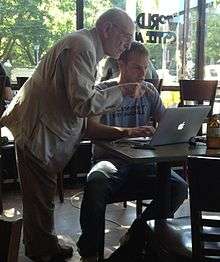Russell A. Kirsch
| Russell A. Kirsch | |
|---|---|
 Russell Kirsch in Portland, Oregon with Joel Runyon [1] | |
| Born | 1929 (age 86–87) |
| Residence | Portland, Oregon, United States |
| Education | Bronx High School of Science (1946), BEE New York University (1950), SM Harvard University (1952), American University, Massachusetts Institute of Technology[2] |
| Occupation | Computer scientist |
| Known for | First digital image scanner |
| Spouse(s) | Joan (née Levin) Kirsch |
| Children | Walden Kirsch (KGW reporter), 3 other children[3] |
Russell A. Kirsch (born 1929) is an American former engineer at the National Bureau of Standards who developed the first digital image scanner.
Background

Education
Kirsch attended the Bronx High School of Science, graduating in 1946. He continued his education at New York University in 1950, Harvard University in 1952, and later the Massachusetts Institute of Technology.[2]
Personal life
Kirsch is married to Joan (née Levin) Kirsch. Kirsch has spent most of his professional life in Washington, D.C. where he was affiliated with the National Bureau of Standards (now the National Institute of Standards and Technology) for nearly 50 years. Now retired, he resides in Portland, Oregon.[3][4]
Career
In 1951 Kirsch joined the National Bureau of Standards (NBS) as part of the team which ran SEAC, the Standards Eastern Automatic Computer.[2] SEAC was the U.S.'s first stored-program computer to become operational, having entered service in 1950.[5]
In 1957, Kirsch's group developed a digital image scanner, to “trace variations of intensity over the surfaces of photographs”, and made the first digital scans. One of the first photographs scanned,[6] a picture of Kirsch’s three-month-old son, was captured as just 30,976 pixels, a 176 × 176 array, in an area measuring 5 cm × 5 cm.[7] The bit depth was only one bit per pixel, stark black and white with no intermediate shades of gray, but by combining several scans made using different scanning thresholds, grayscale information could also be acquired.[6] They used the computer to extract line drawings, count objects, recognize alphanumeric characters and produce oscilloscope displays.[7] Kirsch also proposed the Kirsch operator for edge detection.
Later in life, Kirsch became the director of research of the Sturvil Corporation and an advisory editor for the Institute of Electrical and Electronic Engineers (IEEE). He is currently the advisory editor of the journal, Languages of Design.[2]
Accomplishments
Because of its importance in the development of digital photography, in 2003 Kirsch's scanned picture of his son was named by Life magazine one of the “100 Photographs That Changed the World”.[7] The original image is in the Portland Art Museum.[3] Although Kirsch did not work for NASA, his invention led to technology crucial to space exploration in the 1960s and beyond, including the Apollo moon landing. Medical advancements such as Sir Godfrey Hounsfield’s CAT scan can also be attributed to Kirsch’s research.[7]
References
- ↑ Runyon, Joel (Aug 2, 2012), "An Unexpected Ass Kicking", ImpossibleHQ.com
- 1 2 3 4 Kirsch, Russell A., "Russell A. Kirsch", NISTS Museum; SEAC and the Start of Image Processing at the National Bureau of Standards, National Institute of Standards and Technology
- 1 2 3 Woodward, Steve (May 11, 2007), "Russell Kirsch: The man who taught computers to see", The Oregonian, OregonLive.com
- ↑ Ehrenberg, Rachel (2010-06-28). "Square Pixel Inventor Tries to Smooth Things Out". Wired News. Retrieved 1 July 2010.
- ↑ Kirsch, Russell. “Computer Development at the National Bureau of Standards.” National Bureau of Standards. 31 March 2010.
- 1 2 Kirsch, Russell A., "Earliest Image Processing", NISTS Museum; SEAC and the Start of Image Processing at the National Bureau of Standards, National Institute of Standards and Technology
- 1 2 3 4 Newman, Michael E (24 May 2007), "Fiftieth Anniversary of First Digital Image Marked", Tech Beat (news release), NIST, retrieved 31 March 2010.
Further reading
- "Computer Development (SEAC and DYSEAC)" (PDF), Circular, Washington, D.C.: National Bureau of Standards, 551, January 25, 1955.